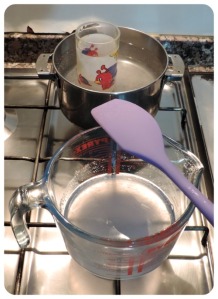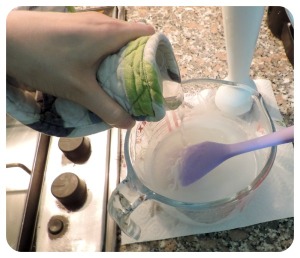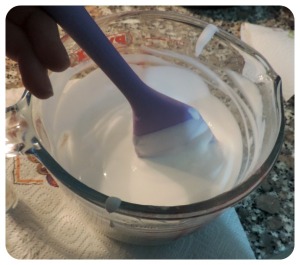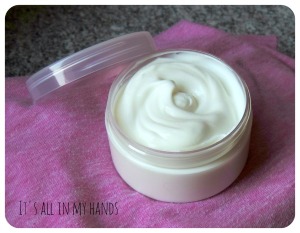HOW TO ACTUALLY MAKE A LOTION/CREAM?
As explained in the “Theory pt.1” post a cream is made of water and oils kept together by emulsifiers (one or more in the same formulation).
So, when you attempt to actually make a cream, you have to start preparing the ingredients separately. There will be at least:
PHASE A: the water based ingredients
PHASE B: the oily ingredients (or oil soluble ingredients)
I think it is better to actually show a very basic recipe of a cream so you can understand what I am talking about.
Every recipe is made for 100 grams of product and every number written after the ingredient indicates the grams (“water to 100” means that the water will be enough to make the recipe reach the 100 gr value)
BASIC BODY CREAM:
Phase A:
water (demineralized) to 100
glycerin 4
xanthan gum 0.3
Phase B:
fats 15
emulsifier 3 (imagine I have chosen one which need to be heated)
thickener 2
Phase C:
Active ingredients 5
Preservative 0.6
2 drops fragrance oil or essential oil
So what does it mean to “make a phase A and a phase B”?
Once you have the recipe you start weighting the ingredients and you cannot put them all together like an unknown mixture: there are rules to be followed and the most important rule is to keep the two phases separated in the beginning.
So you will need at least two bechers and in one you will add the phase A, in the other you will add the phase B.
The PHASE A usually contains water, glycerin, one or more jelling agents (mainly: xanthan gum, different kinds of carbomer or hydroxyethyl cellulose) which help the emulsion to keep stable and they give consistency to the cream. There are different kinds of jelling agents and each gives a final texture to the cream.
The PHASE B instead contains the oily ingredients and the emulsifier, the thickeners if needed and so on. I have not been specific in this recipe neither for the fats nor for the emulsifiers; this because too much must be said about these two subjects and I will make other posts about this.
What we will consider, however, is that the emulsifier in this cream is one of those which have to be heated at 70°C to actually emulsify water and fats.
So, in this case, now that we have the phase A and the phase B we need to heat them up to 70°C (measuring the temperature is important).

Once they have both reached the same temperature, you need to add the Phase B to the Phase A (never otherwise) and you have to start mixing them possibly with an immersion mixer (pay attention at this point: avoid incorporating air or it will result in bubbles inside your cream). Notice that when you pour the Phase B into the Phase A you should actually pour it little by little, mix, add some more, mix, add some more… this will give better results! 😀

Once the liquid (it should still be quite liquid at this point) looks emulsified you have to keep stirring with a spoon until it cools down completely.
When it is cooled down (you will notice that now it looks more like a real cream because it has become thick and creamy 🙂 )

this is the time you can add your PHASE C: the preservative, the active ingredients (the ingredients which are extremely good for your skin) and, if you wish to, two drops of your favourite fragrance oils or essential oils (bear in mind that if you want to add fragrance oils they need to be of cosmetic grade: not any fragrance oil will do).

If it sounded very easy… well it is not really 🙂
I’m not trying to take the motivation away from you, but it is not easy to get a stable emulsified cream; sometimes it gets bubbles inside, sometimes it separates after few days (usually if there are many bubbles it means it is not really emulsified… but I will teach you a trick to get to know if it is emulsified or not). Sometimes things go wrong and you don’t even manage to know why.
So I would suggest that you start reading more and more about how to make creams, also from other websites (I am just summing it up, here… but there are many websites which helped me in learning this wonderful thing so I am sure you can find them interesting also!).
There are so many things to be said about this wonderful subject! 🙂
I feel I forgot to say so much, but I will try to add everything I can to this blog.
Anyway if you decide to study about making creams… ALL THE BEST! 😉 You won’t be left unsatisfied 😀
For various recipes click HERE
To learn how to formulate cosmetics click HERE
For a list of online cosmetic ingredients suppliers click HERE

I am impressed by the quality of information on this website. There are a lot of good resources here. I am sure I will visit this place again soon.
LikeLike
How do I measure water and other liquids in grams? Thanks a lot for a very informative site.
LikeLike
Hello Nina!
When you formulate a recipe, all the cosmetic ingredients which you purchase have a functional quantity they need to reach in order to “work correctly” (just think of the preservative: it needs to be added at a very specific %) therefore we need to make sure that whenever we formulate, we formulate for 100 grams of product.
Only this way we can be sure that all the ingredients we added in our cream are at the correct percentage and are going to work.
So this is how you proceed:
you formulate just writing “water (to reach) 100”, then you add all the ingredients which you want to add in your formula writing the percentage you are going to use in your recipe.
At the very end, you calculate 100 minus the sum up of all the ingredients quantities.
Sounds more difficult than it actually is 🙂
For example, let’s say this is my super simple formula:
– water to 100
– glycerin 5
– gelling agent 0.5
– oils 10
– emulsifiers 3
– preservative 0.5
I will sum up all the quantities of the other ingredients (5+0.5+10+3+0.5 = 19) and then do:
100 – 19 = 81
And 81 grams will be the grams of water needed in the recipe.
The reason why we calculate the water in the very end is because we cannot know in the beginning how much water we need to “reach 100 grams” (which is the same as saying “to reach 100%).
Needless to say, if you need to do more than 100 grams, you just need to multiply all the quantities (for example, if you want to make 500 grams of cream, you multiply all per 5) 🙂
Was it clear? 🙂
LikeLike
Yes, it is clear and thank you for a reply. This might be a silly question but do I measure water in grams on the scale even though it is liquid?
LikeLike
It is not a silly question but YES, you measure it like that! 🙂
All the ingredients are measured on the scale, no “milliliters” allowed 🙂 Only grams.
LikeLike
Well, I made your Hyaluronic Acid Serum yesterday, measured ph very carefully several times 🙂 and it feels very well on the skin. I am so excited! Now I would like to make that zombie eye gel (already ordered all ingredients) but I see that I have to heat it up and that concerns me 🙂
Thank you so much for sharing your experience! This is so exiting!
LikeLike
Hmm no no you don’t have to heat up the zombie vaccine! Now I go to read what I wrote! 🙂
LikeLike
Aaah ok! For the caffeine! 🙂
Well don’t worry: you just have to warm up the water to allow the caffeine to melt properly. That’s all. It won’t need to become too hot and it is a very simple thing to do 🙂
LikeLike
Can I mix two active ingredients in my lotion…like I want to make hydroquinone (5%) and kojic acid(3%) cream…. can I do that?
LikeLike
Hi Sana.
You CAN mix active ingredients however you should check the suggested % of each ingredient and you should try to formulate in the way that active ingredients will work in sinergy.
I think the suggested % for hydroquinone is 0.1% (unless you are not using the pure substance).
About acids… You should create a system that will support them: what is going to be the pH of your cream if you use 3% kojic acid? How are you going to adjust the pH? (Which base will you use?)
Ask yourself questions like “how is hydroquinone going to behave in an acid environment?
If you find that your actives don’t agree with each other, make two different creams each with synergy actives 🙂
Hope this helped!
LikeLike
When stick blending, I often stickblending for 1-2 minutes then rest, stir occasionally and then stickblending for another 1 minute then rest, stir and wait till 45oC. Then I add cool down phase and stickblend it again for 1 minute and then stir occasionally then wait till it reachs <30oC. Then I pour into container. Do you think this method will make emulsion more stable or what?
LikeLike
Hello! 🙂
I don’t use to mix for entire minutes in a row so I cannot say how many minutes I mix, however what is ESSENTIAL is that you keep mixing with a spatula (or, if you can, with a low speed mixer) until the cool down. THIS will improve the stability of the emulsion, otherwise it might happen that what was emulsified at high temperature, will separate at cool down.
Just pay attention at one thing: if in your cool down phase you add nanosomes, using a stick blender is not suggested after you add them because it might damage them.
Otherwise a quick use of the stick blender after the cool down phase is usually a good idea because it improves the appearance of the emulsion and it helps with stability. 🙂
Hope this helped!
LikeLike
Hi,
I’m very happy to come across your website, thank you so much for writing the blogs and sharing your knowledge! I have a question about oil phase add into water phase and it’s never reversed. I find it much easier to pour water phase into oil phase because water is much easier to pour out without leaving much behind in the beaker like oil, and my emulsions have been stable even after couple of months without splitting. So why would that be a must? Thank you for your time.
Stephanie
LikeLike
Actually it isn’t that wrong either to do that. There are, however, so.e emulsifiers that require you to do that.
If you pour water in the oil phase though, it isn’t usually that wrong 🙂
LikeLike
Apart from active ingredients can I use any presentage of my choice in any other ingredients after measuring the p_100
LikeLike
No. Emulsifiers for example have their own concentration range, and can emulsify a range (and kind) of fats… So it is not all arbitrary
LikeLike
Please all active ingredients go for how many presents in a formulation
LikeLike
First of all, thank you for all the the valuable and well explained information you put on the internet 🙂
I’ve been having some trouble with a cream I’ve been trying to make recently and I’ve been thinking that the problem might be in the Phase C being too large/oily. Have you got any idea how much oils/oil soluble ingredients I can add after the emulsion is cooled? Does it make a difference whether my Phase C is more oily things or more watery things? For example, some active ingredients need to be dissolved in oil and are heat sensitive so I would need to put them into phase C but then I’ve had problems with some of the oils seperating out of the emulsion after a few days. Any thoughts on this?
LikeLiked by 1 person
Yes it is very likely that your C phase is too “heavy” to be incorporated once the emulsion has happened. You have to understand that if you use an emulsifying system that needs heating, once it is cooled down it doesn’t really emulsify anything anymore (or almost).
The best thing you can do is to change your emulsifying system and use one that doesn’t need heating! There are many options out there, just check whether they are sensitive to electrolytes (they might be, though not all the cold-emulsifierd are) and if you have many in your formula… Cause electrolytes might break the emulsion. Hope this helped!
LikeLike
Thanks, that confirms what I suspected. All emulsifiers I’ve used so far needed to be melted at a temperature that the more heat sensitive oily ingredients couldn’t take so… this makes a lot of sense! Have you got a favourite no-heat emulsifier system that you would recommend?
LikeLike
I used to use a lot Abil care 85 combined with Tinovis Ade, or Sepigel 305 or Simulgel NS (these are commercial names, not INCI) however nowadays there is really A LOT to choose from and there are even better cold emulsifiers out there. It all depends on the kind of formula you are trying to make and the kind of finish you want to have. Experimenting with emulsifiers is A LOT OF FUN cause they can make or break the formula (I don’t mean it literally here, though it can also be literal sometimes). Some cold emulsifier give a great satin finish, some give a gel-like ultra light texture, some give a rich nurturing finish… It all depends what you want to have as an end product 🙂
LikeLike
Thank you so much for the advice! Agreed, I really enjoy changing small things (emulsifiers or others) about formulations and seeing what differences they make. I try to only make very small portions of the things I make so I can experiment a bit more! I think I’m gonna invest in some cold emulsifiers and in the 4 weeks it will inevitably take them to get to me (I live in the Canary Islands) I will try making the same cream I’ve been trying to make but without the oil in the cool down phase. If it stays together I know that that was the problem. Wish me luck!
LikeLiked by 1 person
Update: I made the cream without the phase C (just added my preservative) and it has stayed together perfectly for about 5 weeks now! So that seems to prove my theory. Hooray for experiments! My cold emulsifiers are still on their way, I can’t wait to play with them 😀
LikeLiked by 1 person